
Kitchen Island, Barn Power – March 2024 Update
Welcome to my shop! This is a quick update to let you know what I’ve been up to. This big chunky thing is the leg
Made from cherry, hard maple, and birch.
This post is a summery of the full Guild project I produced. 36 step by step videos (11+ hours), templates, and plans are available at: https://thewoodwhispererguild.com/product/queen-anne-highboy

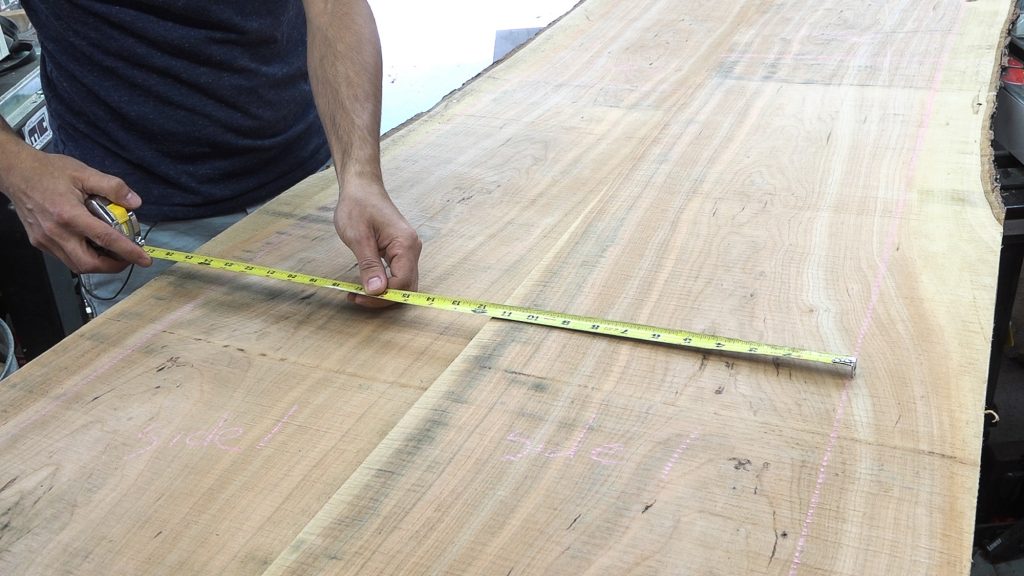
The cherry for the project came from a set of boards that I had been saving for a few years. These are all the boards from one log that I held on to due to them being decently wide. The secondary material for the cases and drawer sides and backs is maple that I’ve also had for a few years. For example the sides of the upper case are a bookmatched pair. I set aside the material for the drawers since I wouldn’t need that for a while and broke down and milled the other boards.
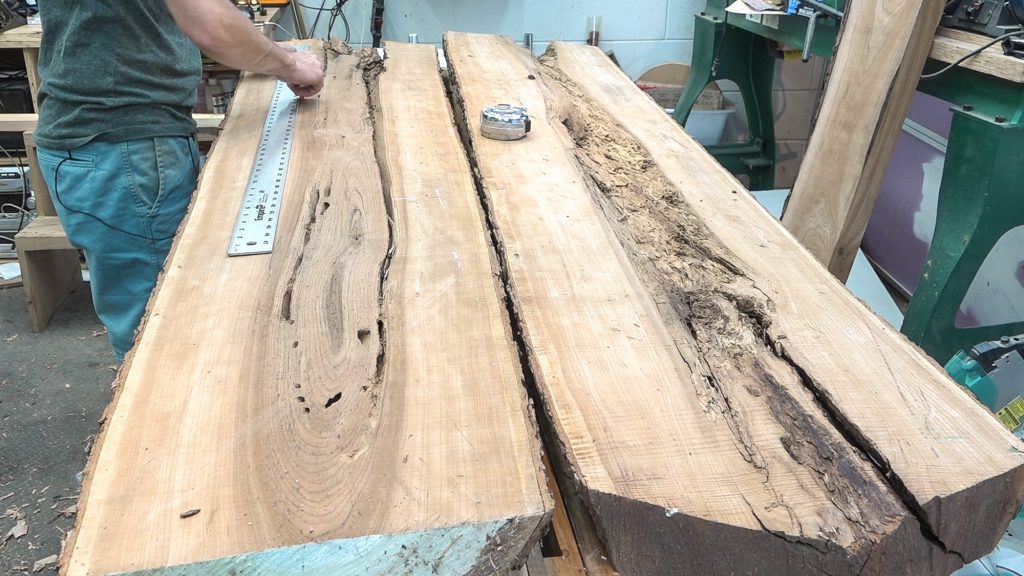
Next I can move on to the leg stock. The stock came from a pair of 12/4 cherry slabs that came from a hollow log. I had been saving these for a while as well specifically for square leg stock and specifically for the day that I would finally build a highboy. These were cut back in 2012.

I’ll start things off by making the cabriole legs. I made a template for the legs and traced that onto two faces of the stock. I’ll make a relief cut at the knee and cut along the lines on one face at the bandsaw. This will remove the layout lines on the other face so I’ll tape those offcuts back on and cut along those lines.
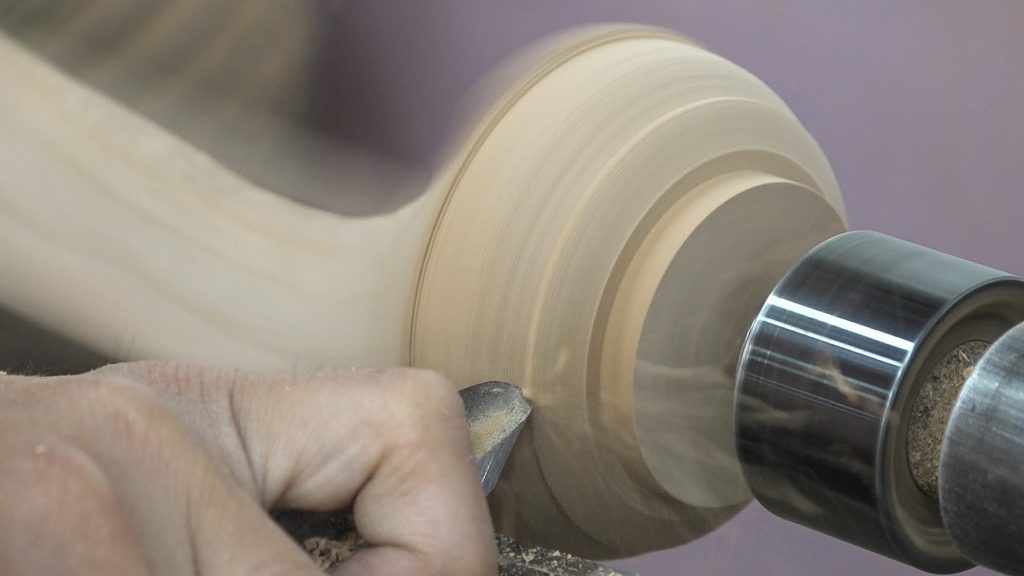
Next is the pad foot which is turned on the lathe.

And the last bit of rough shaping is to reveal the post at the top of the leg.

On to refining and shaping. The bandsaw cuts are smoothed with a plane and spokeshave and the shaping around the top of the foot is done with rasps. The foot curves up into the ankle which is shaped from square into round. The next section is the leg which tapers from square at the knee to round at the ankle – essentially a tapered roundover. And lastly is the cleanup work around the knee.

Moving on to some joinery, the mortises for the side and back panels as well as for the lower front rail are cut into the legs and the tenons can be formed on those mating pieces.
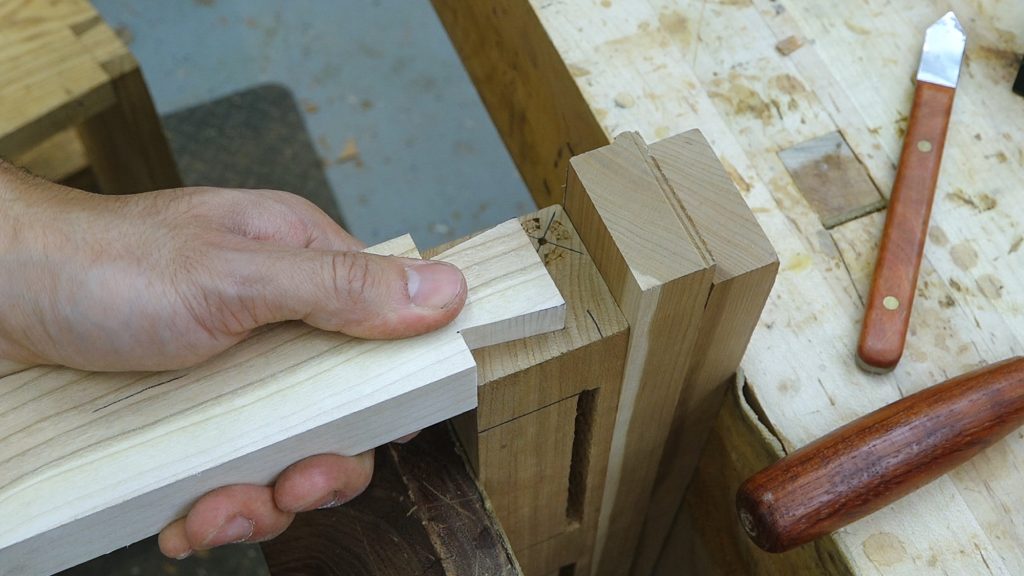
Next are the dovetailed front rails and dividers. The top rail will be dovetailed into the top of the legs. A dovetail is formed on each end and the layout is transferred to the ends of the legs and a matching socket is cut.

Next is the drawer divider. A dovetail is formed on each end and the dovetails are transferred to the legs.

Next are the vertical dividers. These are dovetailed into the lower rail and drawer divider.

Next, the internals can be added. This starts with the addition of the rear cleats which are notched around the legs and screwed to the back panel. The drawer runners are then added with mortise and tenons.
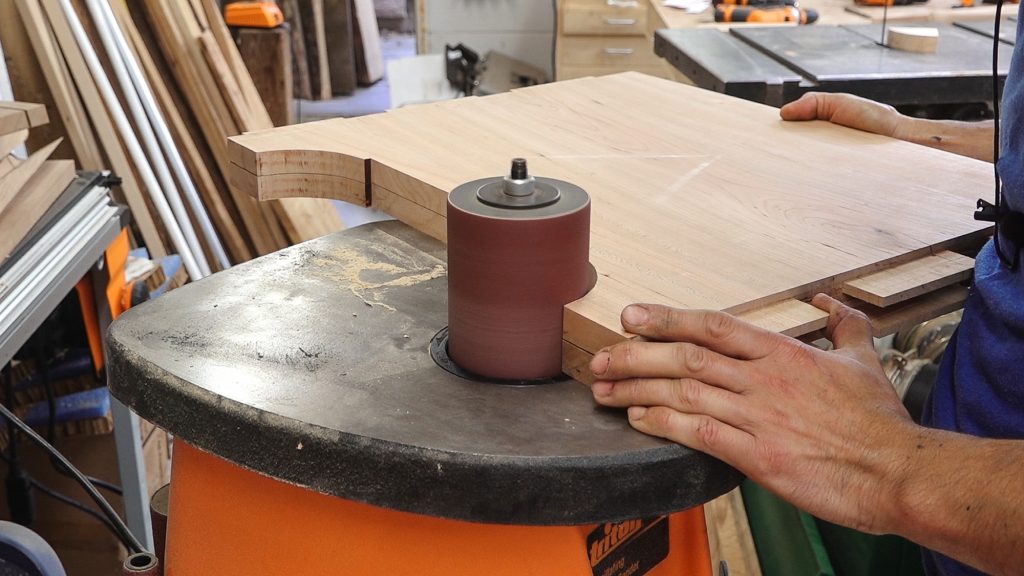
Next the decorative scroll pattern is added to the bottom of the side panels and the bottom of the front lower rail.

To get ready for glue up, holes are drilled into the legs through the mortises which will allow the panels to be pinned in place. The holes are transferred to the tenons, drilled, and elongated to allow for seasonal movement in the panels.

To start the glue up, the rear panel is glued and pegged to the rear legs. Glue is only applied to the top tenon which sends all movement towards the bottom. This will keep the top of the panels flush with the top of the legs over the seasons. The front assembly is glued together as another subassembly. the side panels and drawer internals are installed linking the front and back together.
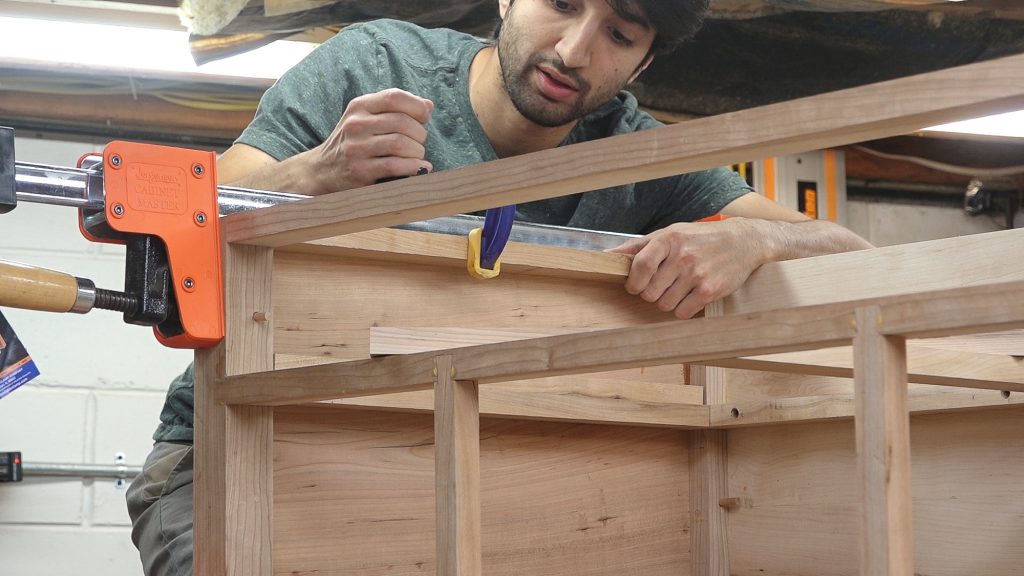
And lastly the drawer guides and top drawer kicker are glued in place.

Next are the knee blocks. These transition the flatness of the case and leg posts into the curves of the legs. They’re cut to have the same curvature as the knees and a pattern is cut into their face and some shaping gives them a curved profile. They are glued to the legs and a bit of clean up work blends the two pieces together.

Now it’s on to the upper case. I’ll get the panels for the sides, top and bottom glued up and cut to final size.

The case is dovetailed together. I’ll start by cutting the tails onto the top panel. Those tails can then be transferred to the sides and the matching pins can be cut on them.

To keep things fun and interesting, the bottom is dovetailed following a pins first approach. These dovetails are structural and will be covered with molding making these a good warm up for the much more visible dovetailing yet to come.
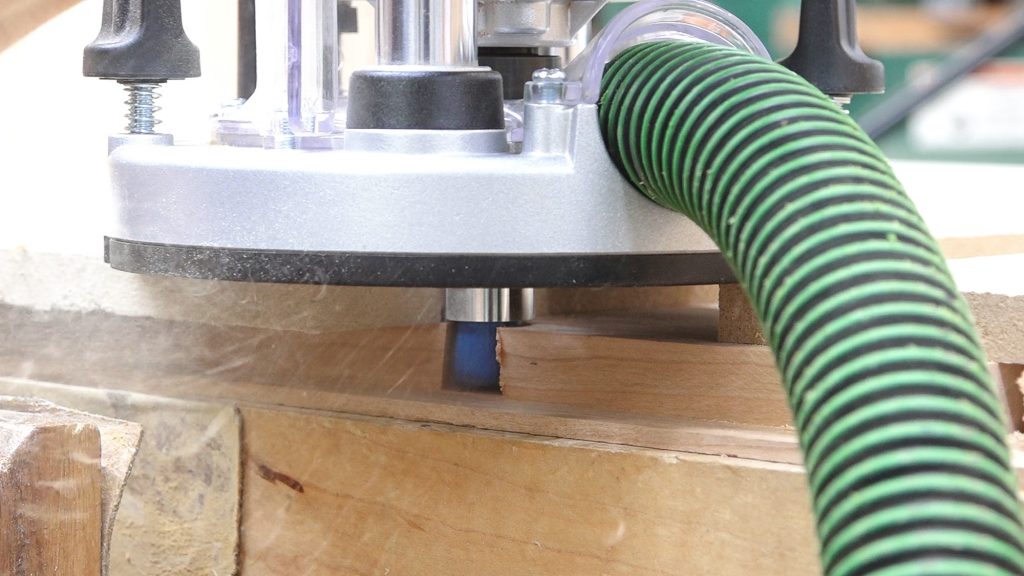
The drawer dividers can be added next. These get joined to the case sides with a sliding dovetail. A router with a dovetail bit and guide bushing follow a mdf spacer to position all four dovetail sockets for each drawer opening consistently from the bottom of the case.

The dividers can be cut to final length and a dovetail is cut into each end. Mortises for the drawer runners are cut and matching tenons are cut into the ends of the runners.

Up next is the scroll board. I’ll use a half pattern to lay out the shape onto the scroll board stock. The shape is rough cut out and flush trimmed to the template with a router. Lastly, the drawer opening can be cut away. To give the scroll board a bit heavier look, material is added to thicken up the center area.
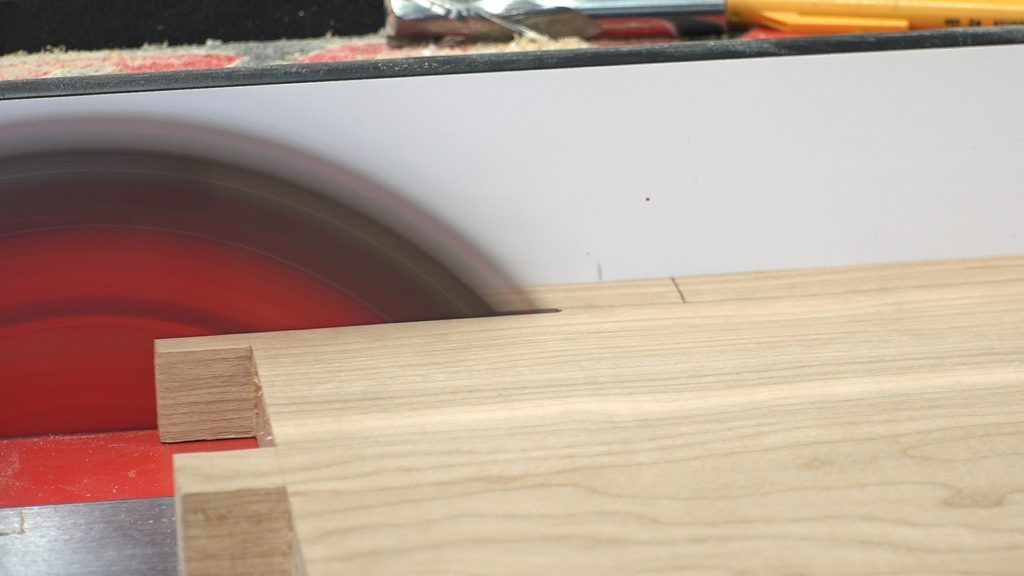
To receive the scroll board, the case sides are notched.

And with that detail out of the way, the upper case can be glued up with the top front divider left un glued for now. With the case flipped over, the supports for the hidden drawers can be added. The vertical dividers for the center drawer can be dovetailed, notched, and installed.

Next is the bonnet top which begins by making the bonnet supports. There’s a rear piece that has the same shape as the scroll board and a connecting piece. And for no practical purpose, I’ll dovetail these together.
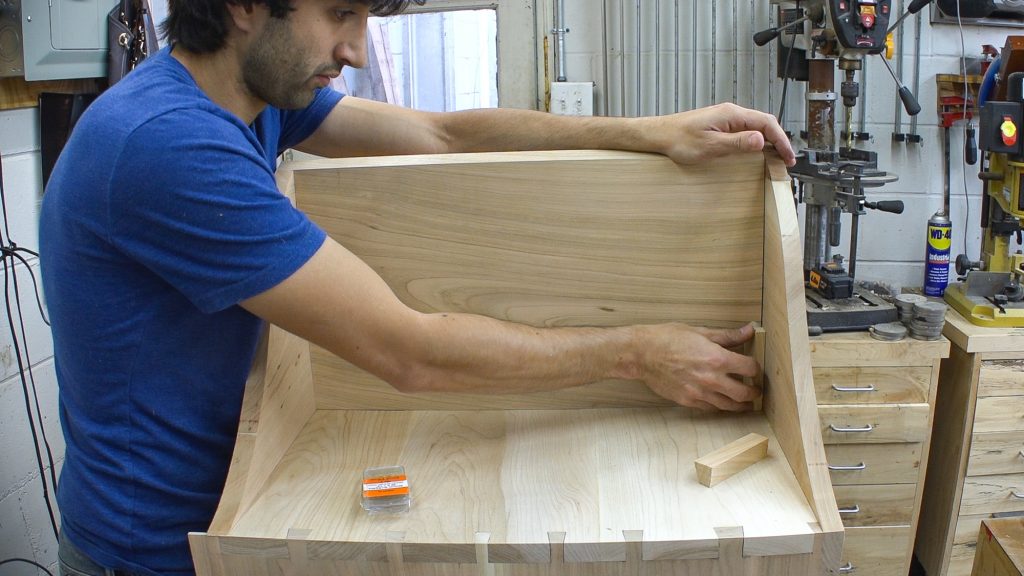
The bonnet supports are installed with glue and glue blocks in the front and screws in over sized holes in the rear.

Next is the stock for the bonnet. I had an offcut from the case that was resawn and brought down to a bit under 1/8” thick. With three slices, I was able to make up a bookmatched panel for each side. I trued up one seam with a plane and did the other on the jointer. Masking tape is used to pull the two pieces together while the glue dries.

Now for the fun part – fitting these to the curvature of the scroll board. A little water applied to the face of the panel causes it to cup. Applying the water to opposite faces causes it to warp into an s curve. This gets it very close to the curvature of the top. The bonnet is glued to the scroll board and bonnet supports using some clamps where they’ll fit and some tape everywhere else. I also hid a note inside the cavity under the top.

The next job is the gooseneck moldings. I made a template of the correct offset curvature relative to the scroll board and used that to layout the parts onto some 12/4 stock. This first piece also provided enough stock for the return moldings. The stock for the goosenecks get cut to rough shape and flushed to the template.
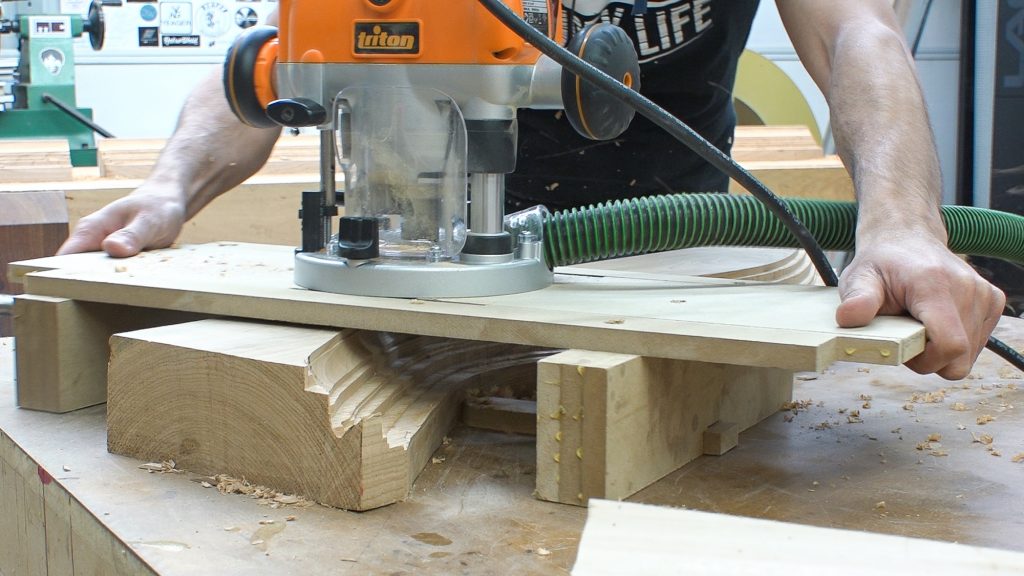
Next, the profile can be routed using an assortment of router bits and a following jig which suspends the router above the work.

Since I’m relying on multiple bits to make up the profile and especially using one smaller cove bit to approximate the large cove, these moldings take a fair amount of clean up work. I do any bulk waste removal with carving gouges then swtich to scrapers and lastly hand sand the entire thing.

Now that they’re cleaned up, they can be separated from the waste. I’ll scribe the cut line and then carefully cut the moldings out at the bandsaw.
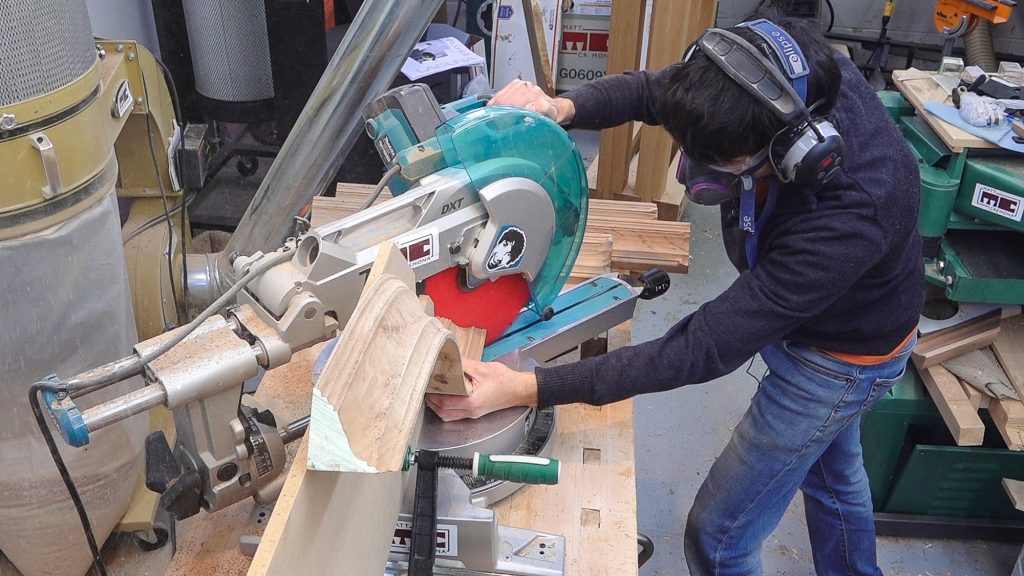
Next I can get into the installation process. The moldings are laid in place and the cut locations are marked. At the miter saw, I’ve created a tall fence with a 45 degree cut on one end. The molding can be stuck down to the tall fence placing the cut directly on the cut line and the miters can be cut on the molding. I did this in a few cuts, sneaking up on the final length.

Next the short top returns can be attached to the goosenecks. These are glued in place and once the glue is set, the joint is reinforced from the rear with a couple dowels.

Since the profiles don’t match up perfectly, the returns are carved to match.

To get ready for the install, a glue well us cut on the back side so glue doesn’t squeeze out along the bottom onto the scroll board.

Once the glue is set, a screw in a vertically elongated hole is added to the top of the gooseneck and the hole is plugged with a dowel.

When I went to install the side returns, I noticed a bit of a happy accident. I didn’t shape the goosenecks so their top would be perpendicular to the side of the case. In order to correct this, the returns would need to angle down so I added some material to the back side and cut a bevel so the return would sit at the right angle. After getting the miter fitting tightly, I could mark out the new profile to match the profile of the gooseneck. The return gets installed with glue at the front and a screw in a horizontally elongated hole in the back. A bit of final shaping clean things up and gets the profiles meeting perfectly at the miter.
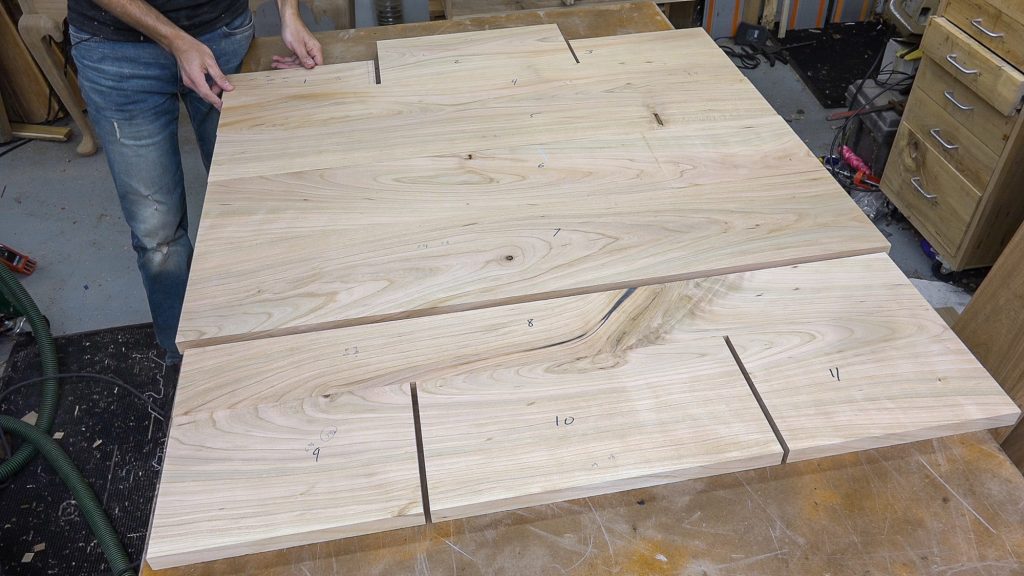
On to the drawer fronts. I’ll work through the stock to get all 11 drawer fronts cut to final length and width. I have some bookmatched drawers and some continuous grain fronts so I pay particular attention at this step to make sure everything lines up correctly once cut. The fronts get a bead detail around all four sides and then receive a rabbet along the sides and top.
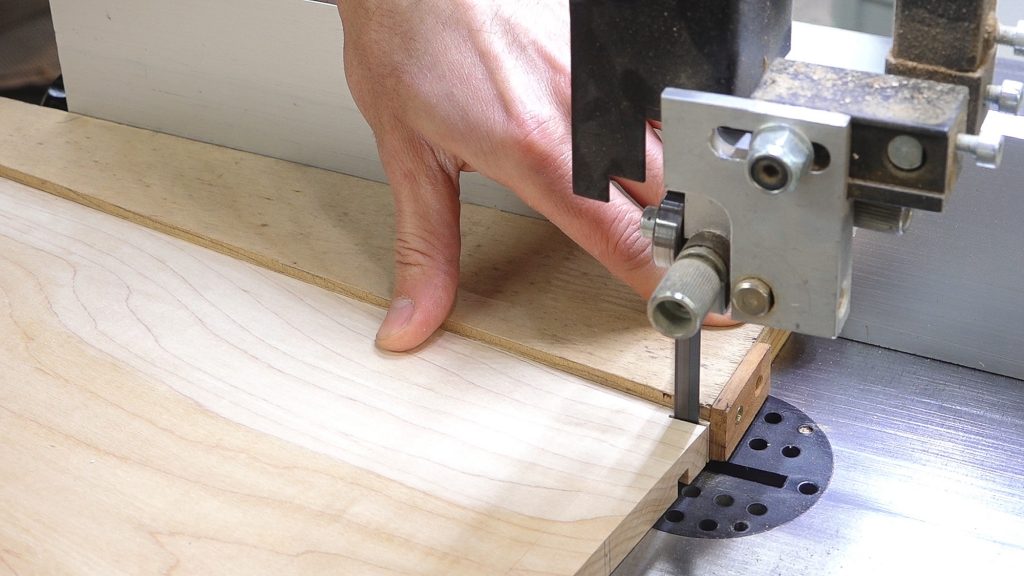
The drawer boxes are made from hard maple so that all gets broken down and planed to thickness. The groove for the drawer bottoms is run in the fronts and sides and then I can get into joining all the drawers with dovetails. I’ll start by laying out the tails on the fronts drawer sides and cut them at the bandsaw. Since I’m going for evenly sized and symmetrical dovetails, the wedge jig makes that super easy. A little clean up work between the tails and they can be transferred to the drawer fronts.

There isn’t a whole lot of room to work in there so I’ll focus on marking the front back of each tail and then connect the lines with a chisel. I’ll use the drill press to remove the bulk of the waste and then chisel my way back to the scribe lines.
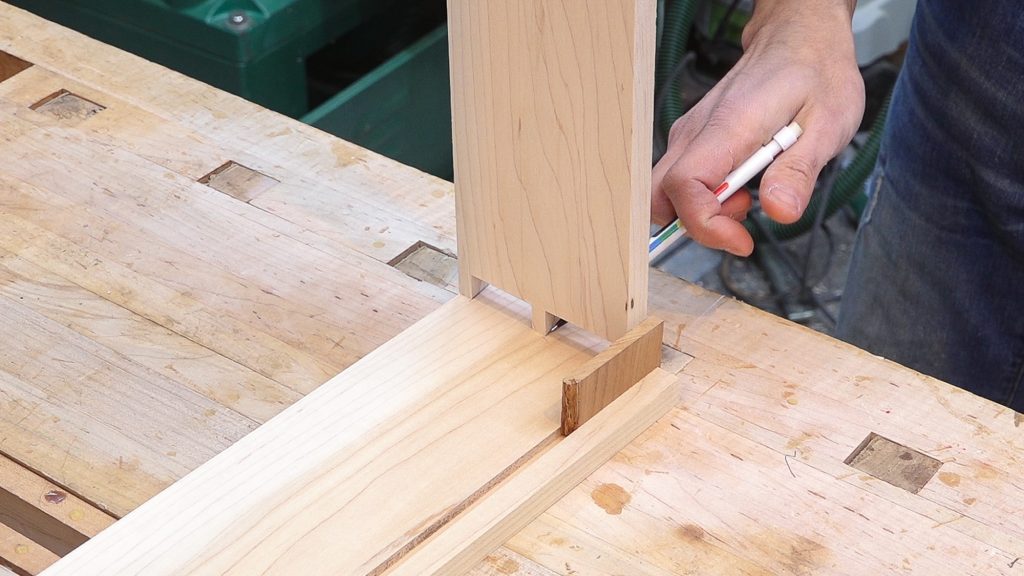
Now for the through dovetails at the rear. I like to cut these pins first so I’ll start by laying out and cutting the pins on the drawer back. The back can then be placed between the sides and the locations can be transferred and the tails cut. And I’ll repeat that process to join all 11 drawers.

Now I can take care of the fan carvings on the two drawer fronts.

I can also add the hidden drawers which are just simple dovetailed boxes with a panel for a bottom.

I found examples of the finials I liked in a couple of the reference books that I have. I printed them at full scale to use a guide. I’ll start off by turning the urns. I’m not that gifted at turning so you’ll see I’ve laid out all the transition points and will take each point down to the correct diameter before doing the shaping. An with all three of them turned, I can cut them apart and drill the mounting hole for the flame.

Next I can make the flames. Those start out by turning the overall shape. Next the spirals can be laid out. To set the depth for carving, I’ll make a cut roughly following the layout lines. Then it’s just a matter of removing the bulk of the waste with a gouge. And the flutes can be refined and brought to final shape with a round file. Some sanding removes the files marks and this flame is done.

The last bit of turning is the drop finials. These will be mounted to the bottom of the lower rail. Same story as the urns. I’m basing the shape off one that I found in a book and I’ll take my time laying everything out so they come out looking at least a little bit similar.

I verified the surface prep on all parts with mineral spirits to spot any issues I missed and moved on to finishing. I applied 5 coats of General Finishes Arm-r-Seal Semi-Gloss sanding between coats with 600 grit sandpaper.

Next up is the transition area. This starts with a frame that will go between the upper and lower case. It is mitered in the front and the rear is joined with a mortise and tenon. The front and sides get a profile routed into them which will become part of the transition molding stack. With the two cases stacked in the house, I can install the transition molding which covers the bottom of the upper case.

The last bit off woodworking is to make the drawer bottoms and backboards. I ran out of the hard maple that I was using as a secondary material so I’m using this birch that I cut in a previous video. It has some really unique colors which should make for some interesting parts. I glued up 7 panels for the drawer bottoms and cut them to size. For the rows with 3 drawers, I cut the bottom stock consecutively so the grain on the drawer bottoms would be continuous across all three.
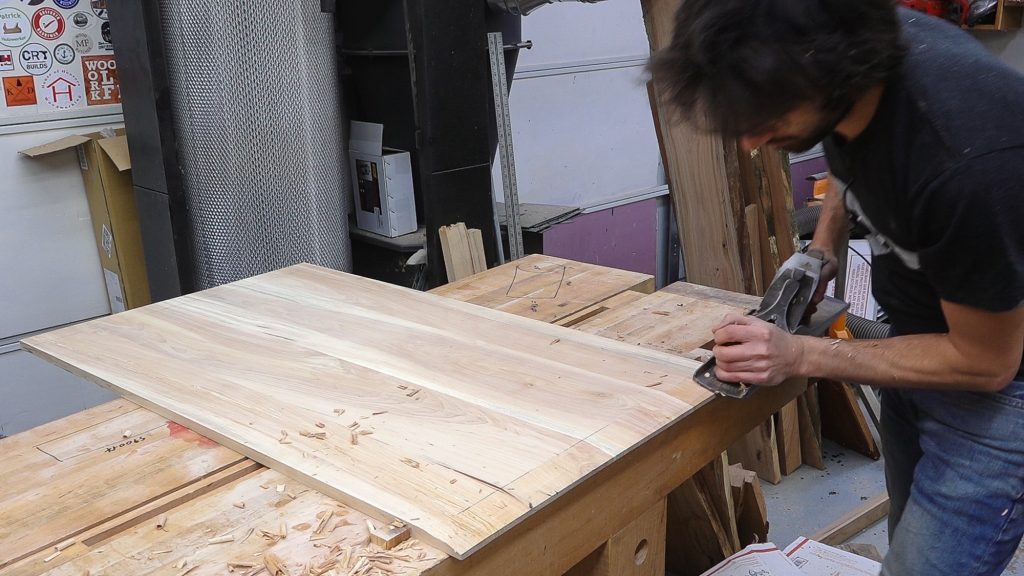
I beveled a couple of the bottoms with handplanes because it’s fun.
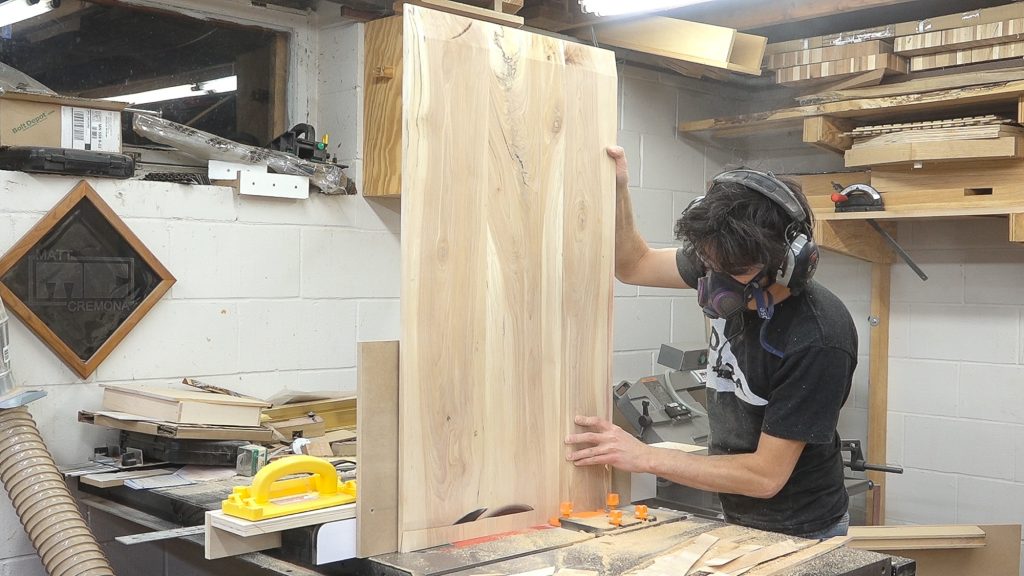
But because there are so many bottoms, I did the others on the table saw.

The backboards are shiplapped and also happen to be bookmatched. I gave them one coat of finish to bring out the colors in the birch a bit and installed them onto the upper case.

Last thing to install is the hardware. The pulls have a backplate, a pair of posts, and a bail (the part you actually pull). Two holes are drilled through the drawer front for the post and the pull can be assembled and secured with a couple nut. The full width drawers also receive a faux keyhole escutcheon. These are secured with a pair of small nails. The carved drawers get a knob at the origin point of the fan.
Router: http://amzn.to/2hXj5AC
Router Table: http://amzn.to/2sbcLLt
Oscillating Spindle Sander: http://amzn.to/2qwZUG8
Table Saw: http://amzn.to/2hXj5AC
Bandsaw: http://amzn.to/2HISAf0
Miter Saw: http://amzn.to/2HD1nPt
Shinto Rasp: http://amzn.to/2phui4C
3/20 Gouge: http://amzn.to/169yjvi
7/20 Gouge: http://amzn.to/2B0PpMS
16/6 V Gouge: http://amzn.to/1wUCHoe
25/6 Back Bent Gouge: http://amzn.to/2hLNB5T
1/2″ Spiral Upcut http://amzn.to/2u1vleb
1 1/2″ Core Box http://amzn.to/1BWRx6m
3/4″ Core Box http://amzn.to/1CP0RbR
3/8″ Ovolo http://amzn.to/2phyb9R
3/16″ Ovolo http://amzn.to/2FFZaGz
Collet Extension http://amzn.to/1949RxK
¾” Dovetail http://amzn.to/2tY76x4
Finish: http://amzn.to/2FFWlVG


Welcome to my shop! This is a quick update to let you know what I’ve been up to. This big chunky thing is the leg

Welcome back to the home renovation. This time I’m going to be working on the kitchen island. Here is a small model of the island.

Welcome back to our home renovation. Today I am going to be working on this wall. It needs some upper cabinets and the surround for
3 Responses
When is the book coming out Matt. I’ve got three of Glen’s books and am working my way through them. It would be nice to work out of one of your books. I know you’ve put a lot of work in all of this project and it shows. Way to go, I love it! Best Regards, Sincerely, jt
I don’t think I could cram it all into a book 😀 Thanks!!!